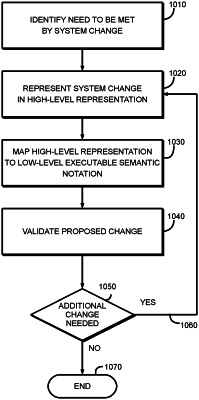| CPC G06Q 10/06 (2013.01) [G06F 8/10 (2013.01); G06F 8/71 (2013.01)] | 10 Claims |

|
1. A computer implemented method of generating a systematic change solution in a system comprising:
identifying an unsatisfied need to be met by the system;
representing a proposed change to the system to satisfy the need in a high-level representation of the proposed change;
evaluating relationships between the proposed change and at least one additional sub-system of the system to identify dependencies between the proposed change and the at least one sub-system;
updating the proposed change in the high-level representation to address an identified dependency;
mapping the high-level representation to a low-level executable semantic implementation model of the system;
identifying a new component required by the system based on the mapping;
running a simulation on the low level executable semantic implementation model of the system including the newly identified component;
iteratively updating the implementation model based on the simulation and validating each updated implementation model through simulation until no further changes are deemed necessary; and
implementing the updated implementation model as changes to the system to improve the system to satisfy the need;
wherein the low-level executable semantic model is consistent with a hybrid communicating sequential processes (HCSP);
cascading an additional change based on the proposed chance to the system; and
wherein the proposed change is a change to a logic program and the additional change is the addition of a hardware sensor to provide an input to the logic program.
|